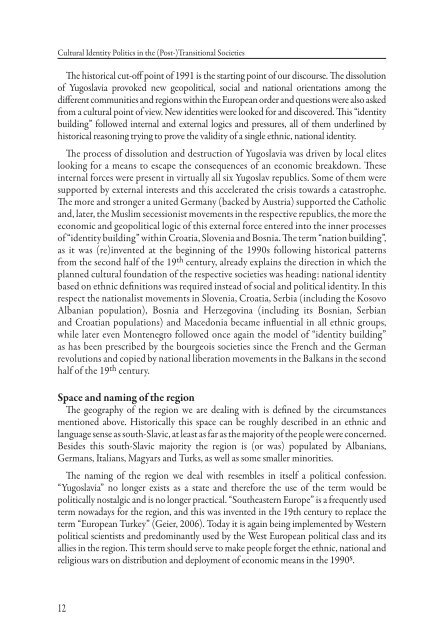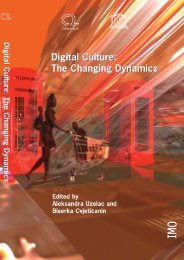free download in pdf format - Culturelink Network
free download in pdf format - Culturelink Network
free download in pdf format - Culturelink Network
Create successful ePaper yourself
Turn your PDF publications into a flip-book with our unique Google optimized e-Paper software.
Cultural Identity Politics <strong>in</strong> the (Post-)Transitional Societies<br />
Th e historical cut-off po<strong>in</strong>t of 1991 is the start<strong>in</strong>g po<strong>in</strong>t of our discourse. Th e dissolution<br />
of Yugoslavia provoked new geopolitical, social and national orientations among the<br />
diff erent communities and regions with<strong>in</strong> the European order and questions were also asked<br />
from a cultural po<strong>in</strong>t of view. New identities were looked for and discovered. Th is “identity<br />
build<strong>in</strong>g” followed <strong>in</strong>ternal and external logics and pressures, all of them underl<strong>in</strong>ed by<br />
historical reason<strong>in</strong>g try<strong>in</strong>g to prove the validity of a s<strong>in</strong>gle ethnic, national identity.<br />
Th e process of dissolution and destruction of Yugoslavia was driven by local elites<br />
look<strong>in</strong>g for a means to escape the consequences of an economic breakdown. Th ese<br />
<strong>in</strong>ternal forces were present <strong>in</strong> virtually all six Yugoslav republics. Some of them were<br />
supported by external <strong>in</strong>terests and this accelerated the crisis towards a catastrophe.<br />
Th e more and stronger a united Germany (backed by Austria) supported the Catholic<br />
and, later, the Muslim secessionist movements <strong>in</strong> the respective republics, the more the<br />
economic and geopolitical logic of this external force entered <strong>in</strong>to the <strong>in</strong>ner processes<br />
of “identity build<strong>in</strong>g” with<strong>in</strong> Croatia, Slovenia and Bosnia. Th e term “nation build<strong>in</strong>g”,<br />
as it was (re)<strong>in</strong>vented at the beg<strong>in</strong>n<strong>in</strong>g of the 1990s follow<strong>in</strong>g historical patterns<br />
from the second half of the 19th century, already expla<strong>in</strong>s the direction <strong>in</strong> which the<br />
planned cultural foundation of the respective societies was head<strong>in</strong>g: national identity<br />
based on ethnic defi nitions was required <strong>in</strong>stead of social and political identity. In this<br />
respect the nationalist movements <strong>in</strong> Slovenia, Croatia, Serbia (<strong>in</strong>clud<strong>in</strong>g the Kosovo<br />
Albanian population), Bosnia and Herzegov<strong>in</strong>a (<strong>in</strong>clud<strong>in</strong>g its Bosnian, Serbian<br />
and Croatian populations) and Macedonia became <strong>in</strong>fl uential <strong>in</strong> all ethnic groups,<br />
while later even Montenegro followed once aga<strong>in</strong> the model of “identity build<strong>in</strong>g”<br />
as has been prescribed by the bourgeois societies s<strong>in</strong>ce the French and the German<br />
revolutions and copied by national liberation movements <strong>in</strong> the Balkans <strong>in</strong> the second<br />
half of the 19th century.<br />
Space and nam<strong>in</strong>g of the region<br />
Th e geography of the region we are deal<strong>in</strong>g with is defi ned by the circumstances<br />
mentioned above. Historically this space can be roughly described <strong>in</strong> an ethnic and<br />
language sense as south-Slavic, at least as far as the majority of the people were concerned.<br />
Besides this south-Slavic majority the region is (or was) populated by Albanians,<br />
Germans, Italians, Magyars and Turks, as well as some smaller m<strong>in</strong>orities.<br />
Th e nam<strong>in</strong>g of the region we deal with resembles <strong>in</strong> itself a political confession.<br />
“Yugoslavia” no longer exists as a state and therefore the use of the term would be<br />
politically nostalgic and is no longer practical. “Southeastern Europe” is a frequently used<br />
term nowadays for the region, and this was <strong>in</strong>vented <strong>in</strong> the 19th century to replace the<br />
term “European Turkey” (Geier, 2006). Today it is aga<strong>in</strong> be<strong>in</strong>g implemented by Western<br />
political scientists and predom<strong>in</strong>antly used by the West European political class and its<br />
allies <strong>in</strong> the region. Th is term should serve to make people forget the ethnic, national and<br />
religious wars on distribution and deployment of economic means <strong>in</strong> the 1990s .<br />
12



